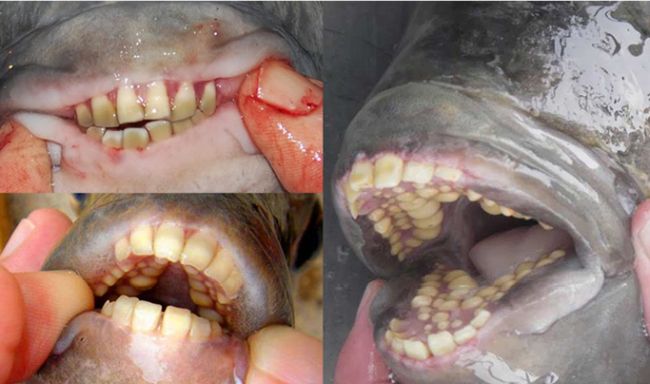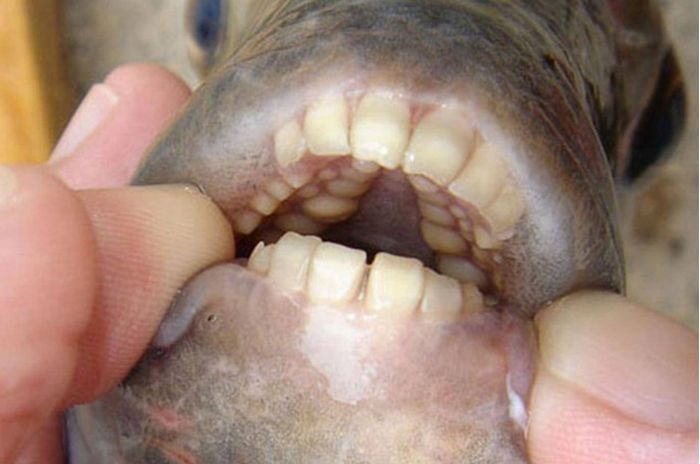There’s a type of fish found in South America, related to the piranha that is commonly called pacu. Although they are related, pacu and piranha have different teeth; one of the main differences is the alignment of the jaw. Piranhas are known for having very sharp and pointed teeth with a very noticeable underbite.
On the other hand, pacu has teeth that are much squarer and straight, which carry an uncanny resemblance to human teeth, which is also marked by a slight overbite or a subtle underbite.
Pacu feeds mostly on plants, not on other fish or scales. They can also get to be quite big, they can reach a length of 3.5 ft and weigh around 88 lb.

Where does the name come from?
The name pacu has a Brazilian Indian/Guaraní origin. When the larger fish of the genus Colossoma made an entrance to the aquarium market in North America, it was labeled pacu.
However, in the Brazilian Amazon, the pacu is used for those that have a smaller or medium size, for example, those in the Metynnis, Mylossoma, MylesinusandMyleus genera.
Where do they live?
Pacus live in the tropical and subtropical areas of South America. They can be found in rivers, lakes, flooded forests and floodplains in the Amazon, Orinoco, Sao Francisco, and Río de la Plata basins, but you can also find them in rivers across the Guianas.
They play an important role in the high diversity of neotropical fish fauna in these areas. Each subtype of pacu has a particular preference when it comes to their habitat and it has been found that some of them are migratory.

They’re an exotic species
Pacus have been introduced to the local waters in many places around the world, inside and out of South America. Sometimes people release them as a way to increase local fishing, but sometimes they’re released by aquarists when they become too large or too many for their aquariums.
This practice is illegal in many countries and it also very strongly advised against. They can be an invasive species and cause serious damage to the local ecosystem.
In some of the regions they have been spotted as individuals, they are likely to perish in the short term because of temperature; of the larger pacu species, the Piaractus are the ones that can bear the coldest temperatures, being capable of living in waters as cold as 59°F, but stops feeding below 64°F.
Pacus and humans
Pacus are widely fished and farmed. They are among the most caught fish in the Brazilian Amazon. They are also sold to home aquarium owners, often sold as “vegetarian piranhas” and when properly taken care of, they can be quite responsive pets.
However, they do require a large tank because their size isn’t limited to their living space; a common misconception. Also, while they’re not really carnivorous, they can bite humans, and very hard. People have been known to need surgery or in some cases even lose their finger to a pacu bite.
They are also a popular dish in many parts of South America, with their flavor sometimes compared to that of tilapia, rainbow trout, and striped bass. They are described as having a sweet and mild flavor.

